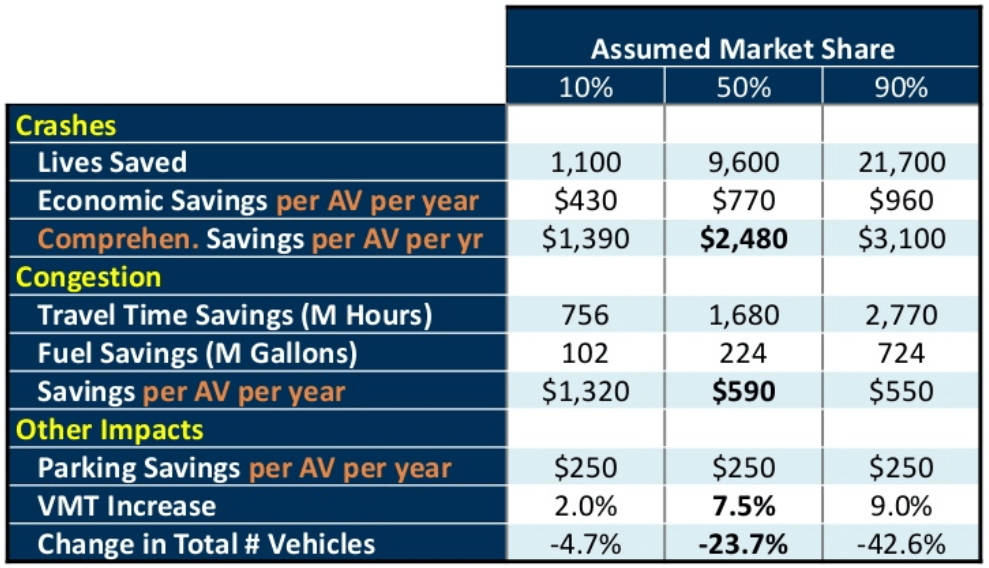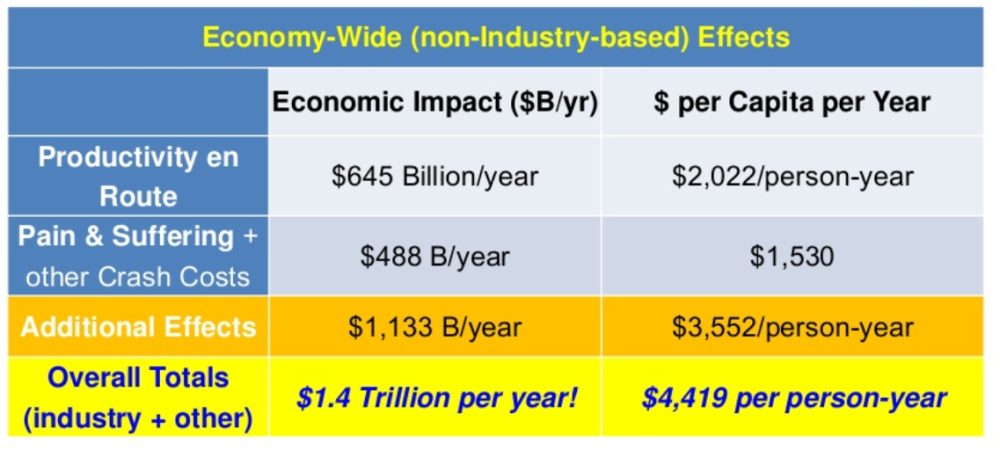Consumer Impacts

Navigant Research predicts that 75% of U.S. vehicles sold in 2035 will have “autonomous” capability. It is thus crucial to analyze the cost benefits of AVs for the owner as well as industries (Navigant Research, 2014).
Reductions in crash frequency and collision severity is the most important benefit of using CAV technology. According to the National Highway Traffic Safety Administration (NHTSA, 2008), driver error is the primary cause for more than 90 percent of crashes in U.S. 40% of the fatal crashes involve alcohol, drugs, fatigue and/ or distraction. This resulted in 32,675 deaths and more than $500 billion in comprehensive costs in 2014 (Kockelman and Loftus-Otway, 2016). AVs may avoid most of these crashes.
As Drs. Daniel Fagnant and Kara Kockelman explain, “major social AV impacts in the form of crash savings, travel time reduction, fuel efficiency and parking benefits are likely on the order of $2,000 per year per AV, or $3,000 eventually increasing to nearly $5,000 when comprehensive crash costs are accounted for” (Fagnant and Kockelman, 2015, p. 1). The worth of AVs to society and individual owners is quantified in the below figure (U.S. context, 2012).

Annual Per-AV Economic Impacts
Source: Kockelman and Loftus-Otway, Slide 9
Future Vehicle Ownership
AV usage frees up travel time during commutes. AVs are extremely beneficial to people with a high value of travel time (VOTT), as these people can be much more productive while traveling in an AV. Thus, AV usage will see maximum return of investment for people belonging to high-income groups. It will also increase personal productivity by providing safe mobility for the disabled and even children.

Source: Kockelman and Loftus-Otway, Slide 12
It is likely that we will see empty vehicle-miles traveled, in order to avoid parking costs. However, this will allow vehicles to be shared among household members and will result in the reduction of vehicle ownership.
Fagnant and Kockelman predict that “most AV benefits will likely exceed the negative impacts of added VMT” (Fagnant and Kockelman, 2015, p. 5). Smarter vehicle operations may reduce the volume of auto repairs, but the cost per repair for vehicles is likely to rise as a result of more complex technology.
Fleet Owners and Truck Platooning
“With AVs we expect to see cost savings for freight movement, but more highway congestion and several changes in origin (and mode) choice, by commodity.” (…) Automated freight transport will be beneficial for fleet owners as it provides increased capacity and saves the cost of hiring human drivers. Reduced labor costs will in turn reduce the shipping costs. They will also see improved fuel economics from tight headway drafting.
Societal Impacts
There are several public benefits as well as conflicts associated with AVs. Due to the convenience of long-distance travel using AVs and SAVs, the use of trains, planes and public transit systems in the city will be largely affected. The biggest challenges for self-driving vehicles are the barriers to implementation, market penetration, and initial costs.
For more information on industry-wide cost benefits, read the Industry Impacts page.
